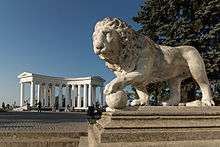Vorontsov Palace (Odessa)

The Vorontsov Palace (Ukrainian: Воронцовський палац; Russian: Воронцовский дворец) is a 19th-century palace and colonnade in Odessa, Ukraine, at the end of the Primorsky Boulevard pedestrian walkway.
History
The buildings were built between 1827 and 1830 by the Sardinian-born architect Francesco Boffo for Prince Mikhail Semyonovich Vorontsov, one of the governor-generals of the Odessa region. Vorontsov chose to build his city palace on the spot where the former governor general Richelieu's humble house had once stood. Vorontsov was so impressed with Boffo's work, that he contracted Boffo to design the Potemkin Stairs.[1][2][3]
In 1906 it became an engineering school. During this time, next to the former palace was Lloyd's Travel Agency where the city's elite could purchase tickets for their trips abroad.[4]
In 1917 it was the headquarters of the Soviet Red Guards, and in March 1917 the first Soviet of Workers' and Sailors' Deputies met in the building.[5]
In 1936 the Vorontsov Palace was acquired by the Young Pioneers, and renamed the Children's Palace.[5]
The present day palace is only the front part of the original structure, the less valuable part of the complex, the Orlov wing was torn down. The Orlov wing was mainly apartments and outbuildings—nicknamed the "Orlovsky outhouse", it stretched from today's Mother-in-Law's Bridge.[3][6]
In the second half of the 20th century, the palace had two fires.[3]
In 1994 sculptor Mikhail Reva built a fountain called "Day and Night" in the courtyard. Unfortunately, the fountain has not had any water since 1999.[3]
See also
- Vorontsov Palace (disambiguation), list of similarly named palaces built for the Vorontsov family
Notes
- ↑ Herlihy, Patricia (1991) [1987]. Odessa: A History, 1794–1914. Cambridge, MA: Harvard University Press. ISBN 0-916458-15-6. p. 133, 337
- ↑ Rhinelander, Anthony L. H. (1990). Prince Michael Vorontsov: Viceroy to the Tsar. Montreal, Quebec; Kingston, Ontario: McGill-Queen's University Press. ISBN 0-7735-0747-7. p. 119.
- 1 2 3 4 Karakina, Yelena; Tatyana Samoilova; Anna Ishchenko (2004). Touring Odessa. BDRUK. ISBN 966-8137-01-9. p. 39 The main corpus was erected in 1824-27, and already in 1828 splendid balls and celebrations took place inside. Construction was completed in 1829.
- ↑ Herlihy p. 263
- 1 2 Kononova, G. (1984). Odessa: A Guide. Moscow: Raduga Publishers. p. 47.
- ↑ Odessa, An Almanac
Coordinates: 46°29′34″N 30°44′19″E / 46.49278°N 30.73861°E